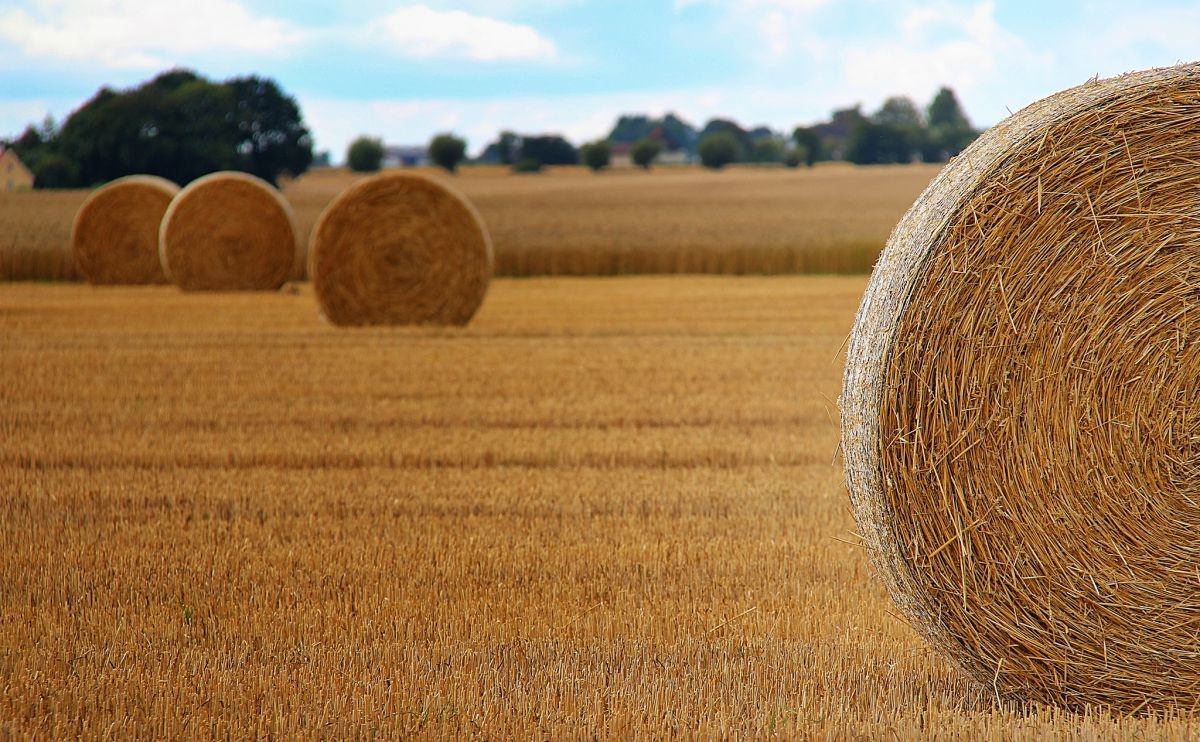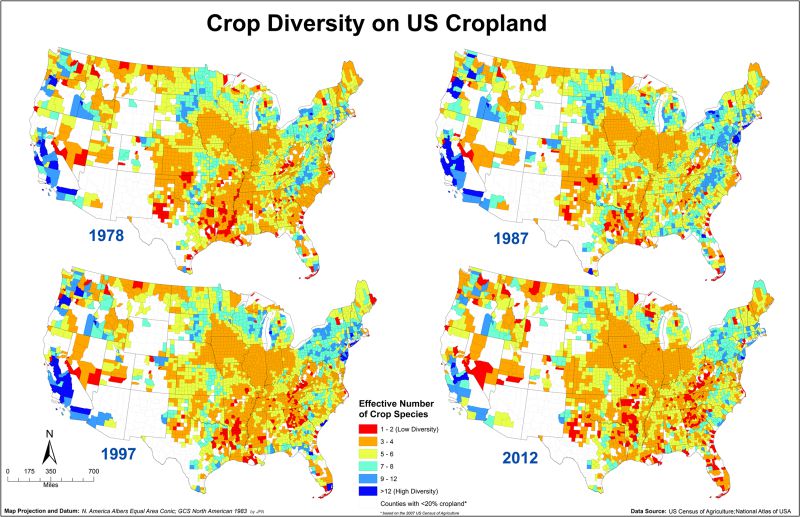Only One Region Has Better Crop Diversity Now Than 34 Years Ago
And it doesn’t make up for downward trending diversity in other regions.
Only One Region Has Better Crop Diversity Now Than 34 Years Ago
And it doesn’t make up for downward trending diversity in other regions.

The study – which was published in the scientific journal PLOS One, and led by Kansas State University, North Dakota State University, and the US Department of Agriculture itself – looked at the USDA’s crop diversity data spanning from 1978 to 2012, a period of time that’s seen a few key upheavals in the way agriculture works in this country. One is the great rise in ethanol, and the need for plants that can be used to fill our gaping maw for fuel. Another is globalization and the narrowing of key crops for export around the world. But these trends, among many others, have affected different regions in different ways.
As a whole, crop diversity is lower than it was in 1978, which is kind of crazy given what we know now about the importance of diversity. In recent years, farmers have begun to realize the holistic nature of agriculture; that every little thing depends on every other little thing, and that scrapping dozens of crops for just a single one – like, say, corn, or soybeans – can have some nasty effects. From Sustainable Table:
Biodiversity is important at all scales of the agricultural landscape. From billions of different soil microbes that help cycle nutrients and decompose organic matter, to wasps and bats that help reduce crop pests, to birds and insects that pollinate high value crops, biodiversity helps farmers successfully grow food and maintain sustainable farm landscapes.
The new study maps in ever-tightening circles, so we can see trends from the country as a whole down to broad growing regions down to even individual counties. What it finds is that crop diversity is heavily affected by the country’s breadbasket, from the Dakotas down to Texas and as far east as Ohio. On the coasts, crop diversity took a dive from 1978 to about 1987, and then raised to right around its 1978 levels by 2012. And one region, the Mississippi Portal Region (which includes parts of Mississippi, Louisiana, Kentucky, and Arkansas) actually raised its crop diversity in the period measured.

Where things swing south is in the biggest growing regions in the country. The Heartland Resource Region, which includes all of Illinois, Indiana, and Iowa, and parts of Ohio, Missouri, Minnesota, South Dakota, Nebraska, and Kentucky, contributes 22 percent of all US farms, and had by far the lowest crop diversity. That region’s diversity has steadily dropped since 1978, with the many farms focusing almost exclusively on corn and soybeans. You can read the entire study here.
Follow us
This work is licensed under a Creative Commons Attribution-NoDerivatives 4.0 International License.
Want to republish a Modern Farmer story?
We are happy for Modern Farmer stories to be shared, and encourage you to republish our articles for your audience. When doing so, we ask that you follow these guidelines:
Please credit us and our writers
For the author byline, please use “Author Name, Modern Farmer.” At the top of our stories, if on the web, please include this text and link: “This story was originally published by Modern Farmer.”
Please make sure to include a link back to either our home page or the article URL.
At the bottom of the story, please include the following text:
“Modern Farmer is a nonprofit initiative dedicated to raising awareness and catalyzing action at the intersection of food, agriculture, and society. Read more at <link>Modern Farmer</link>.”
Use our widget
We’d like to be able to track our stories, so we ask that if you republish our content, you do so using our widget (located on the left hand side of the article). The HTML code has a built-in tracker that tells us the data and domain where the story was published, as well as view counts.
Check the image requirements
It’s your responsibility to confirm you're licensed to republish images in our articles. Some images, such as those from commercial providers, don't allow their images to be republished without permission or payment. Copyright terms are generally listed in the image caption and attribution. You are welcome to omit our images or substitute with your own. Charts and interactive graphics follow the same rules.
Don’t change too much. Or, ask us first.
Articles must be republished in their entirety. It’s okay to change references to time (“today” to “yesterday”) or location (“Iowa City, IA” to “here”). But please keep everything else the same.
If you feel strongly that a more material edit needs to be made, get in touch with us at [email protected]. We’re happy to discuss it with the original author, but we must have prior approval for changes before publication.
Special cases
Extracts. You may run the first few lines or paragraphs of the article and then say: “Read the full article at Modern Farmer” with a link back to the original article.
Quotes. You may quote authors provided you include a link back to the article URL.
Translations. These require writer approval. To inquire about translation of a Modern Farmer article, contact us at [email protected]
Signed consent / copyright release forms. These are not required, provided you are following these guidelines.
Print. Articles can be republished in print under these same rules, with the exception that you do not need to include the links.
Tag us
When sharing the story on social media, please tag us using the following: - Twitter (@ModFarm) - Facebook (@ModernFarmerMedia) - Instagram (@modfarm)
Use our content respectfully
Modern Farmer is a nonprofit and as such we share our content for free and in good faith in order to reach new audiences. Respectfully,
No selling ads against our stories. It’s okay to put our stories on pages with ads.
Don’t republish our material wholesale, or automatically; you need to select stories to be republished individually.
You have no rights to sell, license, syndicate, or otherwise represent yourself as the authorized owner of our material to any third parties. This means that you cannot actively publish or submit our work for syndication to third party platforms or apps like Apple News or Google News. We understand that publishers cannot fully control when certain third parties automatically summarize or crawl content from publishers’ own sites.
Keep in touch
We want to hear from you if you love Modern Farmer content, have a collaboration idea, or anything else to share. As a nonprofit outlet, we work in service of our community and are always open to comments, feedback, and ideas. Contact us at [email protected].by Dan Nosowitz, Modern Farmer
September 23, 2015
Modern Farmer Weekly
Solutions Hub
Innovations, ideas and inspiration. Actionable solutions for a resilient food system.
ExploreExplore other topics
Share With Us
We want to hear from Modern Farmer readers who have thoughtful commentary, actionable solutions, or helpful ideas to share.
SubmitNecessary cookies are absolutely essential for the website to function properly. This category only includes cookies that ensures basic functionalities and security features of the website. These cookies do not store any personal information.
Any cookies that may not be particularly necessary for the website to function and are used specifically to collect user personal data via analytics, ads, other embedded contents are termed as non-necessary cookies.